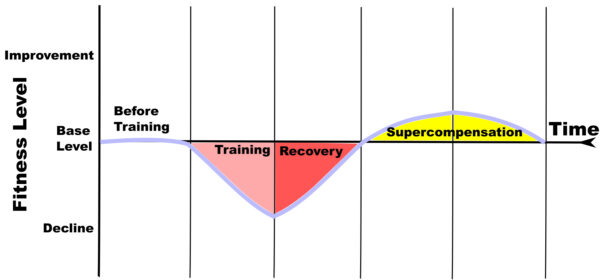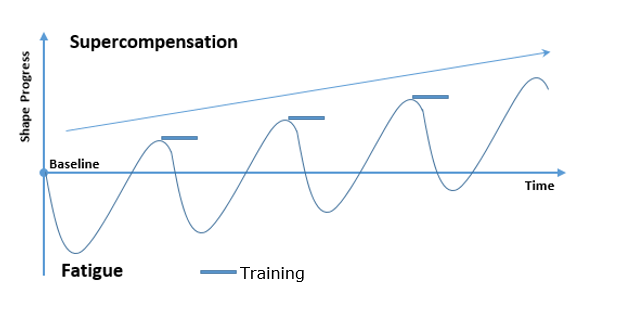How to make progress in running is supercompensation, which is about impacts on the body from an external load. When we achieve sports in general, we want this outer impact to make the body stronger than before we started. This process is called Supercompensation.
So, how to make progress by running with Supercompensation means, we aim to control the outer impact that comes by running, which loads the body in many different ways. Thus, various tissue types as muscles, tendons, heart, and lungs will be loaded during marathon training. As a starting point, all physical training causes a breakdown of the tissue that is being loaded.
No Progress in Running is no Supercompensation

If you always run the same route at the same pace with the same finish time, you get no success in your progress. Because the body during the recovery returns to the same level, as before you started your run. This is because the route you always run once loaded your body, got it to adapt and be stronger.
Afterward, you have just maintained this basic level. If you want to get in better shape, you have to load your body more to make progress. But more doesn’t mean that you can run with higher intensity exactly as you want. The process has to be managed.
Progress in Running
Supercompensation gives training progress and stronger tissues. Simplified we could say that a slight breakdown of the tissue is a precondition for the body to overcompensate, which in practice means re-build itself to a stronger version than before the run.
If the periods between your running sessions are too long before the body is loaded again, decreases the supercompensation progress, and we are back to the basic level again.
Waiting even longer, decreases our performance and tissue strength weakens. If we on the other hand load the body too quickly again, before it has re-build itself – at least back to where we began our run – there will be a breakdown of the body’s tissue. This means a decrease in performance rather than a build-up and a shape progress.
The Supercompensation Phase
When the run is over, your body will begin rebuilding the decomposed tissues. The rebuilding phase (recovery phase), has as the first objective, to regain the strength in the loaded tissue and to create or redress the balance particularly in muscle energy depots and in the body’s fluid- and hormone quantity.
When the balance is re-established and the loaded tissue has regained its strength, the recovery continues into a new phase called supercompensation.
In the supercompensation phase, the body continues the build-up, which began during the recovery phase. But the body increases its strength compared to the starting point before the run. You begin to get in better shape.
So, with well-planned training with an appropriate combination of load (training) and recovery, you can manage your progress by increasing the training volume/intensity gradually from the “plateau” where you are now, to the next higher “plateau” and so on.
Supercompensation is a Build-up System
Below in Figure 1 is a diagram showing supercompensation – yellow color.

This concept underlies every effective marathon training plan. Time your sessions right—and you’ll build strength, endurance, and resilience with each cycle.
The diagram in Figure 2 shows the supercompensation principle over a longer time:

The Body Gets Stronger With The Right Training
When you run, you expose the body to a load it has to respond to. The processes are a bit complex, but in short, the training breaks down your body i.e. you are destroying the muscle fibers and emptying particular your sugar depots.
During the breaks between your training sessions, the body responds by building itself stronger, so it has a better starting point than before you started the training. Then it is better prepared to cope with the next physical challenge you are exposing it to.
However, the training only works to a certain limit. Because if you push the body too much without giving it breaks, your cells will no longer rebuild themselves between the training sessions. They break down and it either gets harder to recover or you get an injury. So, the Supercompensation curve will go downwards in this case like in overtraining.
All types of training are about keeping the focus on the target, having the right mindset, and paying attention to the body’s signals.
A better training strategy
So, instead of training with the head under the arm by going after quick results, we should try to hit the load that causes the body to return to the best state for rebuilding itself according to the supercompensation principle, as illustrated in Figure 1 above.
The load depends, among other things, on:
- The fitness rate – That you can improve in two ways either by increasing your maximum oxygen uptake or by minimizing your bodyweight – losing weight.
- Your running economy – With a better running economy, you can run faster and longer without using more effort.
- Your endurance – how close you can run with your maximum oxygen uptake during the time the chosen race lasts.
Taking breaks between training sessions
Trained Re-charging, meaning the breaks between the training sessions, is the basis on which we can build strength and progress. If you want to be stronger and in better shape, the rules are few but simple.
Teach yourself to create strong waves of Re-charging to the same extent as you create waves of training. As you probably have noticed, these rules also apply to activities in our everyday lives.
The course of a thorough recovery phase (Re-charging) and subsequent supercompensation takes time. How long it takes before the body has completed its recovery, and before the body is in the supercompensation phase depends on several things:
Training intensity (how hard you train) and training volume (how much you train) are very important for the length of these phases. Repeated runs regularly will result in changes in the body. Changes that overall are called improved fitness.

To build up strength and a good shape is a kind of system with “rest plateaus” and “stair steps”. For each step you take upward, it is necessary with a plateau where you can rest before you take the next step upward.
Your Running Experience
The relationship between training and rest, between the “rest plateau” and “stair step” is different for each of us because we do not have the same running experience and starting point. Therefore, it is not possible to be general in how often and how hard you have to train but it’s about 1 – 3 days recovery between the training sessions.
You have to try it yourself but of course, some guidelines are matching your running level. Since the tissue breaks down during the training and slowly builds up again to a higher level, there will be no progress without the balanced rest periods.
If you do not provide the body with sufficient restitution, the training will have the opposite effect. The body weakens and you risk getting an injury. The tissue rebuilds and reinforces with different speeds over time, and this is very important particularly if you are beginner:
Muscles: After 2 to 3 weeks there can be measured an increased strength of muscle tissue.
Bones: After about 3 months, the bones have evolved to the same level as the muscles.
Tendons: After about 6 – 9 months, the tendons have evolved to the same level as the muscles.
As you can see, the training can have consequences. While muscles easily can withstand and adapt to the training, bones and tendons need a longer time. This is the reason why many running injuries are tendon injuries.
Supercompensation – Manage the Progress

A progression of 5 – 8 percent weekly is optimal. But we must take into consideration that a beginner in distance running with experience from other sports, will have a better starting point.
The progress will be higher in the first period and can be done with higher intensity, as this person often already has developed sufficient strength in muscles, bones and tendons from the other sport. I experienced that at the beginning of my running career. I came from many years of soccer to long-distance running.
Earlier a 10 percent progression was recommended. But experiences with Periodization among other things where the goal is to avoid stagnation and ensure a shape top at the right time showed that the number of injuries was too high with 10 percent.
So, experience tells us that it’s necessary to increase training more slowly. It is also recommended that every two or three weeks a restitution week has to be added where the training is reduced by approx. 50 percent.
Final Thoughts
As you can see, an understanding of the supercompensation principle will be a precondition for choice- and proper training planning for performing your training sessions. By structuring your training around the supercompensation principle, you can avoid hitting a performance plateau and thereby stagnate in your training.
In a well-planned training program, the supercompensation principle also acts as a control point in your training cycle, which you can work towards hitting when you get further on in the program and learn more about your own reactions to the training.
It’s not the intention that The body should supercompensate after each training session, but once you find the balance between recovery/training in a proper way, you should notice the positive effects of supercompensation every 2 -3 weeks.
If you are interested in Supercompensation like me, I hope you like this page and if you have any questions about this topic or want to leave your own Personal review, please leave a comment below.







Once in a while I come across some stuff I didn’t know but this is something I was never gonna know in this manner of not wasn’t for you. I guess you have got to run with tactic then unlike what I’m used to doing i just run whenever I feel I like and don’t apply these concepts. So that time you will be feeling your body ache is partly recovery and supercompensation period?
Hi Donny
Thank you for the comment. Happy that you could learn something from it.
In making a plan and a decision to follow your plan – you control your feelings,
and then new things start to happen. Often with the same progress pattern as the
Supercompensation.
Be well
hellooo dear,wow what a nice content you have here about super compensation it really is amazing, i was actually doing some research online when i saw your site, i really do fancy these post alot, your website is plain and simple easy to navigate and understand, i really do fancy these post alot thanks i already saved these post so as much as to come back for future reference
Hi Skuchmane
Thank you for the comment. I really appreciate it. Happy that you finding it interesting.
Be Well
Hello there thanks for the review it was really helpful I must say. Well Supercompensation is found almost everywhere in training. You know it as the effects of training hard, but scientifically it’s referred to as supercompensation. If you push it too hard, you run the risk of overtraining. The supercompensation period can last for 5 to 10 days.
Hi Philebur
Thank you for the comment.
You always have to find a balance in work vs rest or you risk running out of fuel.
Supercompensation principle illustrates, how you can get progress when managing this relationship.
Be Well